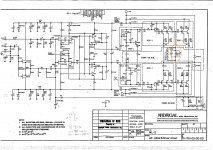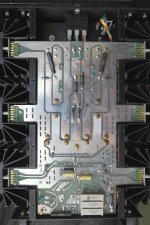Dear all,
I have just replaced all the transistors(2N5686 and 2N5684) on my pairs of Mark Levinson ML-2 with MJ15024 and MJ15025(matched). The result is pretty stable, I am now trying to adjust the bias voltage to .56V(1A current to each transistor) as instructed by the service manual available on the web. But both units seems very hot, I cross check the bias voltage of other ML-2 with original transistor and they are around .4V....am I setting the bias voltage too high? Anyone have some idea this replacement?
I have just replaced all the transistors(2N5686 and 2N5684) on my pairs of Mark Levinson ML-2 with MJ15024 and MJ15025(matched). The result is pretty stable, I am now trying to adjust the bias voltage to .56V(1A current to each transistor) as instructed by the service manual available on the web. But both units seems very hot, I cross check the bias voltage of other ML-2 with original transistor and they are around .4V....am I setting the bias voltage too high? Anyone have some idea this replacement?
50 amps.AVWERK said:From memory, the 5686 combo are rated at 30 amps each
Those are two tough transistors.
"Why do the 50A pairs need replacing?"
It's a 20W class A amplifier, after 30 years it could have just worn out and failed.
The MJ1502X parts should be close enough to work.
I would look at the amp with a scope, the new parts are a bit faster.
Generally, 1A per device (2A for the pair) is enough bias for class A in a push-pull amplifier to do 32W into 4 ohms (64W at 8 ohms).
It's a 20W class A amplifier, after 30 years it could have just worn out and failed.
The MJ1502X parts should be close enough to work.
I would look at the amp with a scope, the new parts are a bit faster.
Generally, 1A per device (2A for the pair) is enough bias for class A in a push-pull amplifier to do 32W into 4 ohms (64W at 8 ohms).
Thanks for all the help.
It is because serving over 30 years, those 2N5686/84 were out of specs and some even show very small output.
I know that even Mark Levinson Dealers are using MJ15024/25 to replace 2N5686/64 as they are no longer available. That's why I make the choice to replace both units by matched pairs MJ15024/25.
Both units seems working very well after the replacement, but sounds pretty hash for the mean while. I think they need sometime to break-in.
My concern is whether I need to change the bias level. For using MJ15024/25.
Dennis
It is because serving over 30 years, those 2N5686/84 were out of specs and some even show very small output.
I know that even Mark Levinson Dealers are using MJ15024/25 to replace 2N5686/64 as they are no longer available. That's why I make the choice to replace both units by matched pairs MJ15024/25.
Both units seems working very well after the replacement, but sounds pretty hash for the mean while. I think they need sometime to break-in.
My concern is whether I need to change the bias level. For using MJ15024/25.
Dennis
It is still a current On-Semi device, and available through Digikey here...emergency said:I know that even Mark Levinson Dealers are using MJ15024/25 to replace 2N5686/64 as they are no longer available.
I'd keep the same bias setting as the manufacturer recommends.My concern is whether I need to change the bias level. For using MJ15024/25.
Dennis
Hi Dennis,
Bias is normally measured as a current value across the emitter resistors. Measuring the E-B voltage will no longer work as these are different parts. Bring the bias up until the amp just starts to draw maore current. Let it sit and make the heatsink run around the same temperature. If you can measure what the bias is on a working unit, set it the same. The E-B voltage will be lower than the old ones.
Noramally when an amp is set up like than, it's just barely on or almost on for bias current. I am not familiar withthis particular amplifier.
-Chris
Bias is normally measured as a current value across the emitter resistors. Measuring the E-B voltage will no longer work as these are different parts. Bring the bias up until the amp just starts to draw maore current. Let it sit and make the heatsink run around the same temperature. If you can measure what the bias is on a working unit, set it the same. The E-B voltage will be lower than the old ones.
Noramally when an amp is set up like than, it's just barely on or almost on for bias current. I am not familiar withthis particular amplifier.
-Chris
Thanks Chris,
Will try to find some way to measure the bias current properly. Both units seem to sound better 3 days run-in and still improving. I think changing all the transistors to MJ15024/25 is a good move. The most noticeable change is the control and response of the ML-2, seems to be improved a lot.
Thanks for all the help here, I will let you guys know what value I will eventually use.
Will try to find some way to measure the bias current properly. Both units seem to sound better 3 days run-in and still improving. I think changing all the transistors to MJ15024/25 is a good move. The most noticeable change is the control and response of the ML-2, seems to be improved a lot.
Thanks for all the help here, I will let you guys know what value I will eventually use.
emergency said:replace 2N5686/64 as they are no longer available.
Mmm Dennis,
sorry for my late response.
Onsemi does produce the 2N5686 and 2N5684. You can even order samples of the leadfree versions. These devices have an interesting SOA curve.
"These devices have an interesting SOA curve."
Typical for the time of the design. 300W@30V, 150W@50V, 60W@60V.
Nelson Pass used the 2N5684/86 in a high power design, but he had to run three in series.
The MJ15015/16 has 180W@60V for $1.25 in small quantity, and is 4Mhz vs 2Mhz. Is it suitable for the ML design? No, you need more PD (watts), and higher gain. I would use the MJ15024/25 for $2.50 or the similar priced MJ21193/94, they are both 4Mhz and 250W@60V.
Typical for the time of the design. 300W@30V, 150W@50V, 60W@60V.
Nelson Pass used the 2N5684/86 in a high power design, but he had to run three in series.
The MJ15015/16 has 180W@60V for $1.25 in small quantity, and is 4Mhz vs 2Mhz. Is it suitable for the ML design? No, you need more PD (watts), and higher gain. I would use the MJ15024/25 for $2.50 or the similar priced MJ21193/94, they are both 4Mhz and 250W@60V.
thanks Echo Wars.
I did tried to tune it to .56V but cannot move forward after reaching .5V. Anything I need to change to reach .56V?
Dennis
Yes the red circled 12 Ohm/5W resistor that's reachable from the bottom of the amp to 30 Ohm/5. The you will expand your reach with the biaspot and you can get the .56V as specified.
It's the smallest one nearest to the circuitbreaker the one right and somewhat higher then the small cental one.
It has no silver circuittrace beneath it.
Attachments
Last edited:
thanks Echo Wars.
I did tried to tune it to .56V but cannot move forward after reaching .5V. Anything I need to change to reach .56V?
Dennis
It's not really critical, with .50V you still manage 40 Watts Class A, @ 8 Ohms, 80 Watts Class A @ 4 Ohms and 50 Watts Class A @ 2 Ohms (140 Watts AB)
Hello Brian,
If 40watts class-a @8, shouldn't it be 20 watts class-a @4 , 10 watts class-a @2.. ?
Regards,
No, the ML-2 limiting factor is it's maximum of only 17 Volts RMS output with a 28V regulated rail. It's biased at 4 Amps (when on spec: .56V at the testpoints) en could deliver 256 Watts Class A at eight Ohms when sufficient Voltage was available but there isn't, 128 Watts at 4 Ohms 64 Watts Class A at 2 Ohms. The 64 Watts at 2 Ohms is reachable with 17 Volts at a 2 Ohm load.
That's why Madrigal could get 100 Watts Class A from a no. 20 which has almost the same hardware as the ML-2, because the railvoltage is much higher (or secondaries from the Xformer) and it can develop 35V RMS at it's outputs.
Nelson Pass does basically the same with his line of X and XA amps. Same hardware but different Class A numbers.
- Status
- This old topic is closed. If you want to reopen this topic, contact a moderator using the "Report Post" button.
- Home
- Amplifiers
- Solid State
- Replace Mark Levinson ML-2 with MJ15024/15025 need help

